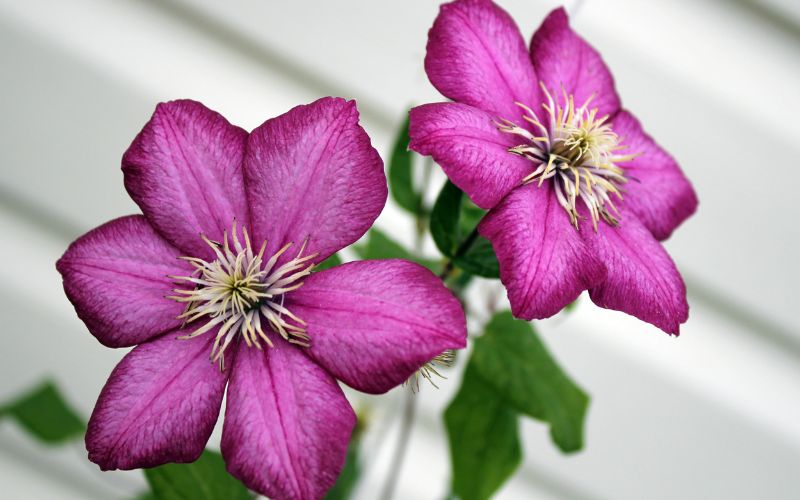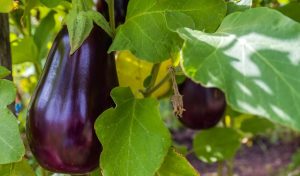For gardeners who love the beauty of clematis but don’t have enough room to plant them in the ground, growing clematis in a pot is a great option.
In this blog post, we will share tips on how to grow clematis in a pot and provide suggestions on the best types of pots to use.
So if you’re looking for an easy way to add some color and elegance to your garden, try growing clematis in a pot.
Clematis will grow well in pots providing that they have good drainage and are not allowed to dry out. Regular feeding with general purpose fertiliser and redressing with fresh compost at the start of each growing season will help your clematis to grow into a strong and healthy plant.

If you’re like me, then you love the elegant beauty of clematis vines winding their way up a trellis or arbor.
But what if you don’t have enough room in your garden for a full-sized vine?
No problem – you can grow clematis in a pot.
Just make sure to choose a variety that is suitable for container growing.
Clematis are available in both climbing and non-climbing varieties, so there’s sure to be one that will work well in your space.
And don’t forget to give your clematis plenty of water, especially during hot summer months.
With a little bit of TLC, your potted clematis will provide years of beauty and fragrance.
Which varieties of clematis are best for growing in pots?
There are many varieties of clematis that are suitable for growing in pots, but some are better than others.
Here are a few of our favorites:
* ‘Nelly Moser’ – This variety is known for its large, pink flowers that have a creamy-white center. It’s a vigorous climber, so it’s perfect for covering a trellis or arbor.
[amazon box=”B07X7K3MLB” template=”horizontal”]
* ‘Jackmanii’ – This variety is one of the most popular clematis, thanks to its large purple flowers. It’s a vigorous climber, so it’s perfect for covering a trellis or arbor.
* ‘Praecox’ – This variety is a non-climbing clematis that is perfect for growing in pots. It has small, blue flowers and can reach up to 3 feet tall.
* ‘Duchess of Edinburgh’ – This variety is a non-climbing clematis that is perfect for growing in pots. It has large, white flowers and can reach up to 3 feet tall.
[amazon box=”B0B1CTLTKY” template=”horizontal”]
* ‘H.F. Young’ – This variety is a non-climbing clematis that is perfect for growing in pots. It has small, pink flowers and can reach up to 2 feet tall.
If you’re not sure which variety of clematis to choose, ask your local nursery or garden center for their recommendations.
What type of pot is best for growing clematis?
When it comes to choosing a pot for your clematis, there are a few things to keep in mind.
First, make sure that the pot has good drainage. Clematis are sensitive to root rot, so it’s important that the pot you choose has drainage holes in the bottom.

Second, choose a pot that is large enough to accommodate the roots of your clematis. A 15-gallon pot should be sufficient for most varieties.
Finally, make sure that the pot you choose is made of a material that is breathable, such as clay or terracotta.
Avoid plastic pots, as they can cause the roots of your clematis to rot.
When is the best time to plant clematis in a pot?
The best time to plant clematis in a pot is in the spring, after all danger of frost has passed.
To plant your clematis, simply remove the plant from its nursery pot and place it in the center of your chosen pot.
Fill in around the roots with a quality potting mix, such as Miracle-Gro® Performance Organics® All Purpose Container Mix.

Water your clematis well and place it in a location that receives full sun to partial shade.
How often do you need to water clematis growing in a pot?
Clematis growing in pots will need to be watered more frequently than those growing in the ground.
During the hot summer months, you may need to water your potted clematis every day.
To check if your clematis needs water, simply stick your finger into the potting mix. If it feels dry to the touch, then it’s time to water.

Whenever possible, water your clematis in the morning so that the leaves have a chance to dry out before nightfall.
What is the best fertilizer for potted clematis?
The best fertilizer for potted clematis is a slow-release fertilizer that is high in phosphorus.
We recommend using Miracle-Gro® Performance Organics® All Purpose Plant Food, which is designed to help promote blooming.
For best results, apply the fertilizer in early spring, just as new growth begins to appear.
Follow the manufacturer’s instructions for application rates.
Should you prune potted clematis?
Pruning is an important part of keeping your potted clematis healthy and vigorous.
The best time to prune your clematis is in the spring, after the plant has finished blooming.

To prune your clematis, simply cut back all of the stems to about 6 inches above the soil line.
This will encourage new growth and help to keep the plant from becoming too leggy.
What is the best type of soil for pot grown clematis?
The best type of soil for potted clematis is a well-draining potting mix.
We recommend using Miracle-Gro® Performance Organics® All Purpose Container Mix, which contains composted manure and peat moss to help promote healthy growth.
For best results, mix the potting mix with equal parts of perlite or vermiculite to improve drainage.
How often should you repot potted clematis?
Potted clematis should be repotted every two to three years, or as needed.
To check if your clematis needs to be repotted, simply look at the roots. If they are pot-bound or appearing through the drainage holes in the bottom of the pot, then it’s time to repot.

When repotting your clematis, choose a pot that is one size larger than the current pot.
Gently remove the plant from its current pot and loosen any tangled or matted roots.
Place the plant in the center of the new pot and fill in around the roots with fresh potting mix.
Will a pot grown clematis grow better than one in the ground?
Potted clematis have the potential to grow just as well as those planted in the ground.
The main advantage of pot grown clematis is that they can be moved around more easily, which means that you can choose the perfect location for them to thrive.
Another advantage of potted clematis is that they are less likely to suffer from clematis wilt, a common disease that can affect clematis planted in the ground.
Should you deadhead potted clematis?
Yes, you should deadhead your potted clematis regularly to encourage new growth and extend the blooming period.

To deadhead your clematis, simply remove the spent flowers and seedheads.
This can be done by snipping them off with a pair of sharp scissors or by pinching them off with your fingers.
Can a pot grown clematis be planted in the ground?
Yes, a pot grown clematis can be planted in the ground.
Before planting, make sure to loosen the roots and add some compost or other organic matter to the planting hole.
Water the plant well after planting and mulch around the base to help retain moisture.
What is the best way to overwinter potted clematis?
The best way to overwinter potted clematis is to move the pots to a protected location, such as a garage or shed.
If you live in an area where the winters are particularly harsh, you may need to provide additional protection, such as wrapping the pots in burlap or placing them on a bed of straw.

During the winter months, make sure to water your clematis sparingly, as the plant will be dormant and won’t need as much water.
Final Words
Potted clematis are a great way to enjoy these beautiful plants, even if you don’t have a lot of space.
By following the tips in this article, you can ensure that your potted clematis will bloom bountifully for many years to come.






